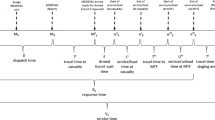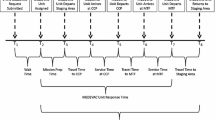Abstract
Military medical evacuation (MEDEVAC) systems respond to casualty incidents and transport the most urgent casualties to a medical treatment facility via multiple types of air ambulance assets. Military MEDEVAC systems are subject to an uncertain number of service calls and each service call demands different system operations depending on type and the priority level. Therefore, military medical planners need an air MEDEVAC asset management system that determines how to dispatch multiple types of air assets to prioritized service calls to maintain a high likelihood of survival of the most urgent casualties. To reach this goal, we propose a novel binary linear programming (BLP) model to optimally locate two types of air assets and construct response districts using a dispatch preference list. Additionally, the BLP model balances the workload among assets and enforces contiguity in the first assigned locations for each air asset. The objective of the BLP model is to maximize the proportion of high-priority casualties responded to within a pre-specified time threshold while meeting performance benchmarks to other types of casualties. A spatial queuing approximation model is derived to provide inputs to the BLP model, which thus reflects the underlying queuing dynamics of the system. We illustrate the model and algorithms with a computational example that reflects realistic military data.



Similar content being viewed by others
References
Ansari, S., McLay, L.A., Mayorga, M.E.: A Maximum Expected Covering Problem for Locating and Dispatching Servers. Under revision at Transportation Science, Virginia Commonwealth University (2014)
Bastian, N.: A robust, multi-criteria modeling approach for optimizing aeromedical evacuation asset emplacement. J. Def. Model. Simul. 7(1), 5–23 (2010)
Bastian, N., Brown, D., Fulton, L., Mitchell, R., Pollard, W., Robinson, M., Wilson, R.: Analyzing the future of army aeromedical evacuation units and equipment: a mixed methods, requirements-based approach. Mil. Med. 178(3), 321–329 (2013)
Bastian, N., Fulton, L.V., Mitchell, R., Pollard, W., Wierschem, D., Wilson, R.: The future of vertical lift: initial insights for aircraft capability and medical planning. Mil. Med. 177(7), 863–869 (2012)
Bastian, N., Fulton, L.V.: Aeromedical evacuation planning using geospatial decision-support. Mil. Med. 179(2), 174–182 (2014)
Batta, R., Dolan, J.M., Krishnamurthy, N.N.: The maximal expected covering location problem: revisited. Transp. Sci. 23(4), 277–287 (1989)
Bouma, M.F.: Medical evacuation and treatment capabilities optimization model metcom. In: Proceedings of Technical Report, Naval Postgraduate School, California (2005)
Budge, S., Ingolfsson, A., Erkut, E.: Approximating vehicle dispatch probabilities for emergency service systems with location-specific service times and multiple units per location. Op. Res. 57(1), 251–255 (2009)
Chelst, K.R., Barlach, Z.: Multiple unit dispatches in emergency services: models to estimate system performance. Manag. Sci. 27(12), 1390–1409 (1981)
Church, R., ReVelle, C.: The maximal covering location problem. Pap. Reg. Sci. Assoc. 32, 101–108 (1974)
Daskin, M.S.: A maximum expected covering location model: formulation, properties and heuristic solution. Transp. Sci. 17(1), 48–70 (1983)
Fulton, L., Lasdon, L., McDaniel, R., Coppola, M.: Two-state stochastic optimization for the allocation of medical assets in steady-state combat operations. J. Def. Model. Simul. 7(2), 89–102 (2010)
Fulton, L., McMurry, P., Kerr, B.: A monte carlo simulation of air ambulance requirements during major combat operations. Mil. Med. 174(6), 610–614 (2009)
Jarvis, J.P.: Approximating the equilibrium behavior of multi-server loss systems. Manag. Sci. 31(2), 235–239 (1985)
Larson, R.C.: A hypercube queuing model for facility location and redistricting in urban emergency services. Comput. Op. Res. 1(1), 67–95 (1974)
Larson, R.C.: Approximating the performance of urban emergency service systems. Op. Res. 23(5), 845–868 (1975)
Larson, R.C., McKnew, M.A.: Police patrol-initiated activities within a systems queuing model. Manag. Sci. 28(7), 759–774 (1982)
Mandell, M.B.: Covering models for two-tiered emergency medical service systems. Locat. Sci. 6(1–4), 355–368 (1998)
Marianov, V., ReVelle, C.: A probabilistic fire-protection siting model with joint vehicle reliability requirements. Pap. Reg. Sci. 71(3), 217–241 (1992)
Marianov, V., Serra, D.: Hierarchical location-allocation models for congested systems. Eur. J. Op. Res. 135(1), 195–208 (2001)
McLay, L.A.: A maximum expected covering location model with two types of servers. IIE Trans. 41(8), 730–741 (2009)
Federation of American Scientists. Uh-60 black hawk, uh-60l black hawk, uh-60q medevac, mh-60g pave hawk, hh-60g pave hawk, ch-60 sea hawk. Accessed 13 Nov 2013
ReVelle, C., Marianov, V.: A probabilistic FLEET model with individual vehicle reliability requirements. Eur. J. Op. Res. 53(1), 93–105 (1991)
Zeto, J.F., Yamada, W., Collins, G.: Optimizing the emplacement of scarce resources to maximize the expected coverage of a geographically variant demand function. In: Proceedings of Technical Report, US Center for Army Analysis, Ft. Belvoir (2006)
Acknowledgments
The first and third authors were supported by the U.S. Department of the Army under Grant Award Number W911NF-10-1-0176. The second author was supported by the National Science Foundation under Grant No. DGE1255832. Any opinions, findings, and conclusions or recommendations expressed in this material are those of the authors and do not necessarily reflect the views of the United States Army, National Science Foundation, Virginia Military Institute, Pennsylvania State University, or University of Wisconsin-Madison.
Author information
Authors and Affiliations
Corresponding author
Rights and permissions
About this article
Cite this article
Grannan, B.C., Bastian, N.D. & McLay, L.A. A maximum expected covering problem for locating and dispatching two classes of military medical evacuation air assets. Optim Lett 9, 1511–1531 (2015). https://doi.org/10.1007/s11590-014-0819-6
Received:
Accepted:
Published:
Issue Date:
DOI: https://doi.org/10.1007/s11590-014-0819-6




